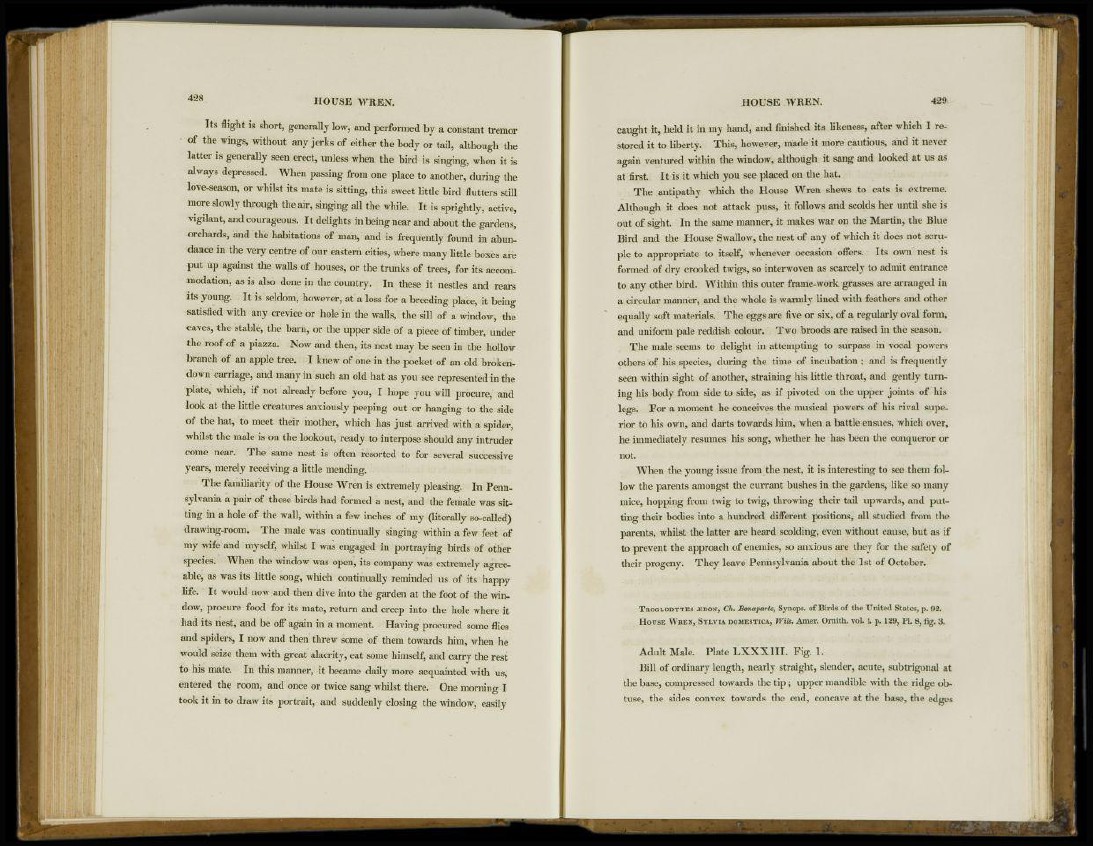
428 HOUSE WREN.
Its flight is short, generally low, and performed by a constant tremor
of the wings, without any jerks of either the body or tail, although the
latter is generally seen erect, unless when the bird is singing, when it is
always depressed. When passing from one place to another, during the
love-season, or whilst its mate is sitting, this sweet little bird flutters still
more slowly through the air, singing all the while. It is sprightly, active,
vigilant, and courageous. It delights in being near and about the gardens,
orchards, and the habitations of man, and is frequently found in abundance
in the very centre of our eastern cities, where many little boxes are
put up against the walls of houses, or the trunks of trees, for its accommodation,
as is also done in the country. In these it nestles and rears
its young. It is seldom, however, at a loss for a breeding place, it being
satisfied with any crevice or hole in the walls, the sill of a window, the
eaves, the stable, the barn, or the upper side of a piece of timber, under
the roof of a piazza. Now and then, its nest may be seen in the hollow
branch of an apple tree. I knew of one in the pocket of an old brokendown
carriage, and many in such an old hat as you see represented in the
plate, which, if not already before you, I hope you will procure, and
look at the little creatures anxiously peeping out or hanging to the side
of the hat, to meet their mother, which has just arrived with a spider,
whilst the male is on the lookout, ready to interpose should any intruder
come near. The same nest is often resorted to for several successive
years, merely receiving a little mending.
The familiarity of the House Wren is extremely pleasing. In Pennsylvania
a pair of these birds had formed a nest, and the female was sitting
in a hole of the wall, within a few inches of my (literally so-called)
drawing-room. The male was continually singing within a few feet of
my wife and myself, whilst I was engaged in portraying birds of other
species. When the window was open, its company was extremely agreeable,
as was its little song, which continually reminded us of its happy
life. It would now and then dive into the garden at the foot of the window,
procure food for its mate, return and creep into the hole where it
had its nest, and be off again in a moment. Having procured some flies
and spiders, I now and then threw some of them towards him, when he
would seize them with great alacrity, eat some himself, and carry the rest
to his mate. In this manner, it became daily more acquainted with us,
entered the room, and once or twice sang whilst there. One morning I
took it in to draw its portrait, and suddenly closing the window, easily
HOUSE WREN. 429
caught it, held it in my hand, and finished its likeness, after which I restored
it to liberty. This, however, made it more cautious, and it never
again ventured within the window, although it sang and looked at us as
at first. It is it which you see placed on the hat.
The antipathy which the House Wren shews to cats is extreme.
Although it does not attack puss, it follows and scolds her until she is
out of sight. In the same manner, it makes war on the Martin, the Blue
Bird and the House Swallow, the nest of any of which it does not scruple
to appropriate to itself, whenever occasion offers. Its own nest is
formed of dry crooked twigs, so interwoven as scarcely to admit entrance
to any other bird. Within this outer frame-work grasses are arranged in
a circular manner, and the whole is warmly lined with feathers and other
equally soft materials. The eggs are five or six, of a regularly oval form,
and uniform pale reddish colour. Two broods are raised in the season.
The male seems to delight in attempting to surpass in vocal powers
others of his species, during the time of incubation ; and is frequently
seen within sight of another, straining his little throat, and gently turning
his body from side to side, as if pivoted on the upper joints of his
legs. For a moment he conceives the musical powers of his rival superior
to his own, and darts towards him, when a battle ensues, which over,
he immediately resumes his song, whether he has been the conqueror or
not.
When the young issue from the nest, it is interesting to see them follow
the parents amongst the currant bushes in the gardens, like so many
mice, hopping from twig to twig, throwing their tail upwards, and putting
their bodies into a hundred different positions, all studied from the
parents, whilst the latter are heard scolding, even without cause, but as if
to prevent the approach of enemies, so anxious are they for the safety of
their progeny. They leave Pennsylvania about the 1st of October.
TROGLODYTES .a-nox, Ch, Bonaparte, Synops. of Birds of the United States, p. 92.
HOUSE WHEN, SYLVIA DOMESTICA, Wits. Amer. Ornith. vol. i. p. 129, PL 8, fig. 3 .
Adult Male. Plate LXXXIII. Fig. 1.
Bill of ordinary length, nearly straight, slender, acute, subtrigonal at
the base, compressed towards the tip; upper mandible with the ridge obtuse,
the sides convex towards the end, concave at the base, the edges